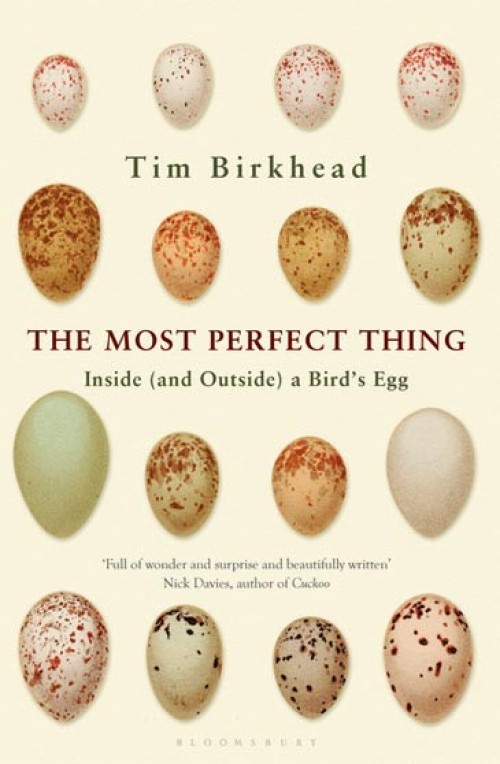by Tim Birkhead
Bloomsbury USA, 2016
I was a bit swamped by new, amazing bird information a couple of years ago when I read Bird Sense, an earlier Tim Birkhead book. This new book, The Most Perfect Thing, is just as good, and it’s shorter, so the reader isn’t waterlogged by the end.
Birkhead has studied guillemots for more than 30 years on Skomer, a rocky island off the coast of Wales. These seabirds (called “murres” on this side of the Atlantic) lay eggs that are endlessly variable in both shape and decoration. That oddity started the author on his study of what he calls “an independent, self-contained embryo development system.” The book describes how bird eggs are fertilized, how shells are made and colored, and how microbes are kept at bay, going on to track the incubation and hatching of a chick.
If you are at all like me, you may have misled many friends and acquaintances by telling them that the reason for the pointy silhouette of seabirds’ pyriform (pear-shaped) eggs is so that they roll in circles on rocky ledges instead of falling into the sea. This book will put an end to that tale – and many other questionable beliefs.
The most studied eggs, of course, are those laid by chickens – but Birkhead explains the development of all kinds of eggs, from the five-gram gold-crest egg to the three-pound ostrich egg, which, as a percentage of the bird’s body weight, is among the smallest.
The membrane that you see when you peel a hardboiled egg is the egg’s first covering – it’s a mat of fibers that can expand, and it is formed before the egg arrives at the uterus. The uterus is also called the shell gland, and it’s there that what he calls “paint guns” spray on calcium carbonate. Next, another group of aerosols sprays on the color coat, and then a final layer of proteins that protect the surface is applied. He likens the final layer to the wax you might put on your car.
Even with all those layers, there is air exchange. Part of the embryo’s network of blood vessels lies outside the body, under the eggshell, and these blood vessels collect oxygen and release carbon dioxide. As the embryo develops, it metabolizes; an egg, regardless of its size, loses about 15 percent of its initial weight during incubation. And the eggshell is thinner at hatching because the chick has taken some calcium for its skeleton.
Far from being just a colorless blob, the albumen, or egg white, is a “biochemical firewall” against microbes. There are more than 100 antimicrobial proteins in albumen, and few nutrients. The nutrients are locked up by certain types of protein, which make them inaccessible to bacteria. Plus, albumen supplies water and acts as a cushion for the growing embryo.
Precocial birds, the ones that walk around and find their own food just hours after hatching, come from eggs that have more yolk and less albumen, but why this is so is a mystery. A kiwi egg is 80 percent yolk by weight and, at the opposite extreme, a northern gannet egg’s yolk accounts for 15 percent of the whole egg.
You may think that by now, I’ve run through all the high points of the book, but I haven’t. Much more of what’s going on inside (and outside) an egg is revealed.
Even if you don’t read The Most Perfect Thing, I recommend trying the book’s suggestion of putting a chicken egg into a jar of vinegar for 48 hours or so to see what happens. It’s egg-laying in reverse, and for me, at least, it’s well worth sacrificing an egg. Even our egg-loving dog wouldn’t eat the end result.


